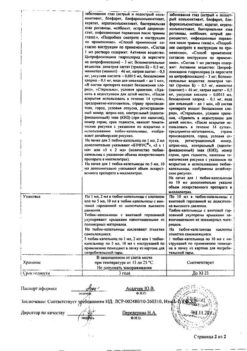No products in the cart.
Ciprofloxacin eye drops 0.3% tube-dropper 5 ml
€1.00
Out of stock
(E-mail when Stock is available)
Description
Ciprofloxacin is a broad-spectrum antimicrobial from the group of fluoroquinolones. It has a bactericidal effect. The drug inhibits bacterial enzyme DNA-gyrase, as a result DNA replication and synthesis of bacterial cell proteins are disrupted. Ciprofloxacin acts both on multiplying microorganisms and on those which are in the quiescent phase.
The following bacteria are sensitive to Ciprofloxacin:
Gram-negative aerobic bacteria: Escherichia coli, Salmonella spp, Shigella spp, Citrobacter spp, Klebsiella spp, Enterobacter spp, Proteus mirabilis, Proteus vulgaris, Serratia marcescens, Hafnia alvei, Edwardsiella tarda, Providencia spp, Morganella mordarii, Vibrio spp, Yersinia spp.
Other Gram-negative bacteria: Haemophilus spp, Pseudomonas aeruginosa, Moraxella catarrhalis, Aeromona, spp, Pasteurella multocida, Plesiomonas shigelloides, Campylobacter jejuni, Neissenia spp.
Some intracellular pathogens: Legionella pneumophila, Brucella spp, Chlamydia trachomatis, Listeria monocytogenes, Mycobacterium tuberculosis, Mycobacterium kansasii, Mycobacterium aviumintracellulare.
Gram-positive aerobic bacteria: Staphylococcus spp. (S.haemolyticus, S.hominis, S.saprophyticus), Streptococcus spp. (St. pyogenes, St. agalactiae).
The sensitivity of the bacteria Streptococcus pneumoniae, Enterococcus faecalis is moderate. Most staphylococci resistant to methicillin are also resistant to Ciprofloxacin.
Corynebacterium spp, Bacteroides fragilis, Pseudomonas cepacia, Pseudomonas maltophilia are resistant to the drug.
Ureaplasma, Clostridium difficile.
The action of the drug against Treponema pallidum has not been studied sufficiently.
Indications
Indications
In ophthalmology:
– Infectious and inflammatory eye diseases.
– Acute and subacute conjunctivitis.
– Blepharitis.
– Blepharoconjunctivitis.
– Keratitis.
– Keratoconjunctivitis.
– Bacterial corneal ulcer.
– Chronic dacryocystitis.
– Meibomitis (barley).
– Infectious eye lesions after injuries or ingestion of foreign bodies.
– Pre- and postoperative prevention of infectious complications in ophthalmosurgery.
Active ingredient
Active ingredient
Composition
Composition
Active ingredient:
Ciprofloxacin hydrochloride monohydrate 3.0 mg ciprofloxacin.
Auxiliary substances:
sodium acetate trihydrate,
mannitol,
dinatrium edetate dihydrate,
How to take, the dosage
How to take, the dosage
Topically.
In ophthalmology:In mild to moderately severe infection, eye drops are instilled into the lower conjunctival sac of the affected eye (or both eyes) every 4 hours; in severe infection, 2 drops every hour. After the condition improves, the dose and frequency of instillation are reduced.
In bacterial corneal ulcer, 1 drop every 15 minutes for 6 hours, then 1 drop every 30 minutes during waking hours; on day 2, 1 drop every hour during waking hours; from day 3 to day 14, 1 drop every 4 hours during waking hours.
Interaction
Interaction
The interaction of Ciprofloxacin drops with other drugs during concomitant use has not been identified.
There is information that systemic use of some quinolones leads to increased plasma concentrations of theophylline, affects caffeine metabolism and enhances the effect of oral anticoagulants such as warfarin and its derivatives. a temporary increase in serum creatinine was reported in patients who received cyclosporine together with systemic use of ciprofloxacin.
Ciprofloxacin is incompatible with alkaline solutions.
Special Instructions
Special Instructions
The solution in the form of eye drops is not intended for intraocular injections.
If other ophthalmic drugs are used, the interval between injections should be at least 5 minutes.
The use of the drug should be discontinued if any signs of hypersensitivity occur.
The patient should be informed that if conjunctival hyperemia continues or increases for a prolonged period of time after application of the drops, the use of the drug should be discontinued and the patient should see a physician.
Wearing of soft contact lenses is not recommended during treatment with the drug. If you use hard contact lenses you should remove them before insertion and put them back on 15-20 minutes after instillation of the drug.
Contraindications
Contraindications
– Hypersensitivity.
– Viral keratitis.
– Childhood (under 1 year).
Side effects
Side effects
Allergic reactions: itching, burning, mild soreness and hyperemia of the conjunctiva or in the area of the external auditory canal and tympanic membrane, nausea; rarely – eyelid edema, photophobia, lacrimation, foreign body sensation in eyes, unpleasant taste in mouth right after dosing, decreased visual acuity, white crystalline precipitate in patients with corneal ulcer, keratitis, keratopathy, corneal stains or corneal infiltration, development of superinfection.
Overdose
Overdose
There are no data on ciprofloxacin overdose when used in the form of eye drops.
In case of accidental oral administration the occurrence of overdose symptoms is unlikely because the content of the drug in one bottle of drops is extremely low (15 mg), at a maximum daily dose for adults of 1 g (500 mg for children).
Consult your doctor if you accidentally take these drops orally.
Similarities
Similarities
Additional information
| Weight | 0.014 kg |
|---|---|
| Conditions of storage | Store in a dry, light-protected place at a temperature not exceeding 25 ° C. |
| Manufacturer | Update PFC AO, Russia |
| Medication form | eye drops |
| Brand | Update PFC AO |
Other forms…
Related products
Buy Ciprofloxacin eye drops 0.3% tube-dropper 5 ml with delivery to USA, UK, Europe and over 120 other countries.

















